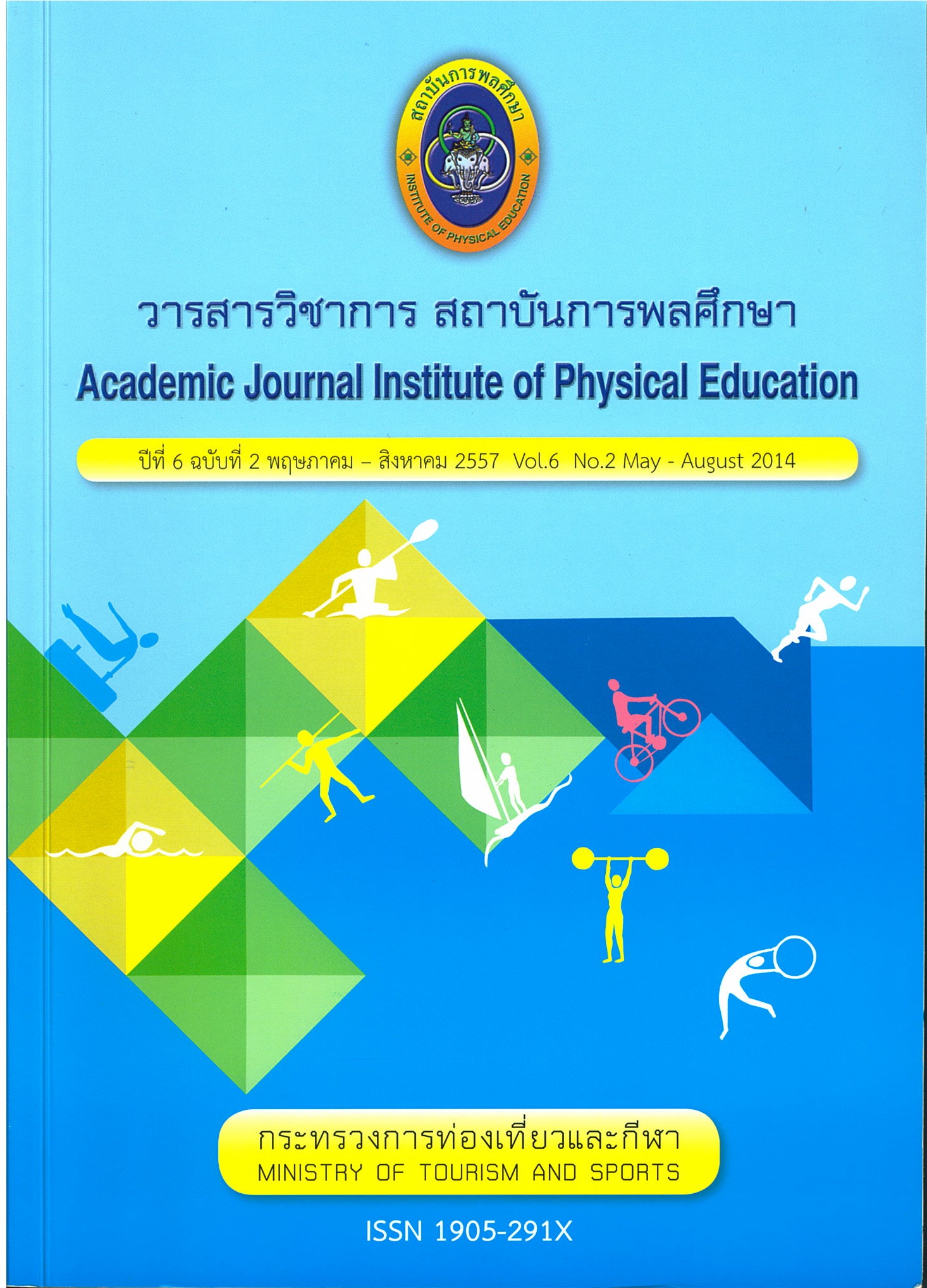Model to Develop Institute of Physical Education into Learning Organization
Main Article Content
Abstract
The purposes of research were to study the learning organization state, to study the factor of development for learning organization and to construct the learning organization model of Institute of Physical Education. The samples were 291 people who are the administrator, lecturer, education personnel and campus committee. The instrument used for collecting the data was questionnaire on the factor of mode development for learning organization of Institute of Physical Education. The data we
statistically analyzed by using percentage, mean, standard deviation, and used factor extraction in exploratory factor analysis, including confirmatory factor analysis.
The results were as follows: (1) The learning organization state of Institute of Physical Education was overall at high level. When considering highest to lowest means they were learning personnel. organization, knowledge management and technology. (2) The factor of development for earning organization of Institute of Physical Education was consisted of 5 main factors, 5 sub-factors, and 29 variables were: 1) learning was consisted of teamwork, 2) organization was consisted of vision and corporate strategy, 3) personnel was consisted of development of personnel, 4) knowledge management was consisted of collaborative learning, and 5) technology was consisted of management information system. (3) The model for learning organization of institute of Physical Education which was using confirmatory factor analysis was consisted of learnin organization. personnel. knowledge management and technology suitable to the empirical data: Chi-Square was 170(p 0.058), RMSEA was 0.141. path coefficient on learning was - 059, organization was 4.23, personnel was - 3.24, knowledge management was 2.34 and technology was - 2.43.
Article Details

This work is licensed under a Creative Commons Attribution-NonCommercial-NoDerivatives 4.0 International License.
The published article is a copyright of the Academic Journal of Thailand National Sports University. The passage appeared in each article in this academic journal is a perspective of each author which is not related to the journal. Each author is required to be responsible for all components of his/her own article. If there are any mistakes, each author must be responsible for those mistakes on his/her own.
References
บุญซม ศรีสะอาด. (2545). การวิจัยเบื้องต้น, พิมพ์ครั้งที่ 7. กรุงเทพฯ : สุวีริยาสาส์น.
วรภัทร์ ภู่เจริญ. (2548). การบริหารคนดื้อ Change Management. กรุงเทพฯ : อริยชน.
วิโรจน์ สารรัตนะ และอัญชลี สารรัตนะ (2545). ปัจจัยทางการบริหารกับความเป็นองค์กรแห่งการเรียนรู้ ข้อเสนอผลการวิจัยเพื่อการพัฒนาและการวิพากษ์, กรุงเทพฯ: อักษราพิพัฒน์.
วีรวุธ มาฆะศิรานนท์ (2542). องค์กรเรียนรู้สู่องค์กรอัจฉริยะ, กรุงเทพฯ : เอ็กซเปอร์เน็ท.
อรจรีย์ ณ ตะกั่วทุ่ง. (2552). การบริหารทรัพยากรมนุษย์, กรุงเทพฯ : ธรรกมลการพิมพ์.
Kontoghiorghes C, Awbrey S M, Feurig P L. (2005). Examining the Relationship Between Learning Organization Characteristics and Change Adaptation, Innovation, and Organizational Performance. Journal: Human Resource Development Quarterly, Summer 2005, Volume: 16 Issue: 2 pp.185-211.
Marquardt, M., & Reynolds, A. (1994). The global learning organization. BurrRidge, IL: Irwin Professional.
Michael J. Marquardt. Building the Learning Organization : Mastering the 5 Elements for Corporate Leaning. New York: McGraw-Hill, 1996.
M.pedler, J. Burgoynes and T. Boydell. (1991). The Learning Company: A strategy For sustainable development. Mardenhead: McGrar-Hill.
J.Bennette and M. O'Brien. (1994). The Building Block of the Learning Organization.
Training Peter M. Senge, Peter Senge and the Learning Organization (Online), accessed 12 February 2006, Available from http://www.infed.org/thinkers/senge.htm.
V.Marsick and K. Watkins. The Learning Organization : an Integrative Vision for HRD. Human Resource Development Quarterly, 1994.


